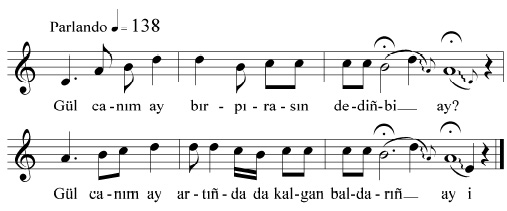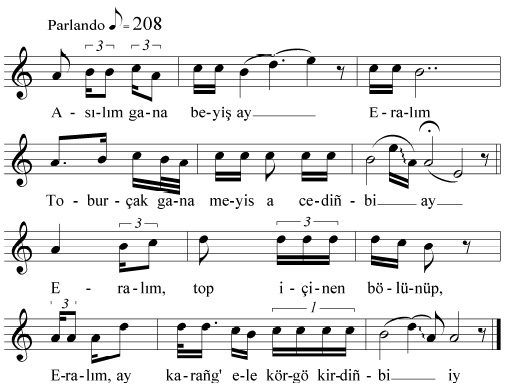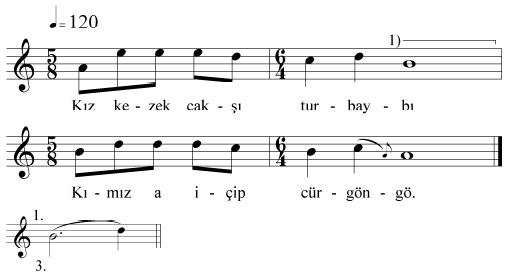- 1. Twin-bar tunes (ex.1-11, №1-58)
- Twin-bar tunes based on the g,-c bichord
- Twin-bar tunes based on rotating motifs
- Twin-bar tunes with descending/hill-shaped lines
- Motifs with a downward leap at the end of the line
- Motivic processes
- 2. Tunes moving on Ionian scales (ex.12-24, №59-164))
- Laments and their relatives
- Two-lined tunes of Major character with higher main cadences and their four-lined relatives
- Four-lined tunes of Major character
- 3. Aeolian tunes (ex.25-36, №165-238)
- Laments and related tunes
- Aeolian tunes with higher main cadence
- Four-lined tunes of Minor character
- Valley-shaped, ascending or undulating first line
- 4. Caramazan religious tunes (ex.37-41, №239-326)
- 5. Tunes of domed structure (ex.42-43, №327-332)
3. Aeolian tunes (ex.25-36, №165-238)
3.1. Laments and related tunes (ex.25-27, №165-192)



3.1.1. Single-core laments and their relatives (ex.25a, №165-169). I arranged in the first group all lamenting and plaintive tunes whose every line closes on the keynote after a descent or a hill-shaped progression, with a fourth leap upward at the beginning or a fourth leap downward at the end sometimes. Their relationship with the earlier laments of Major character is strong. It is noteworthy that the 3rd degree is often uncertain in the laments (as well), which further enhances the similarity between Major- and Minor-character laments. Still, the lament with a clear-pitched Minor third is rarer.
3.1.2. Tune with 1(1)5/6 cadences (№170). There is a single tune here that can be regarded as the direct kin of the single-core lament of Major character .
3.1.3. “Lamenting” tunes built of short lines (ex.25b, №171-179). Although there are fewer laments of Minor character than laments of Major character , the number of formally related tunes built mainly of relatively short lines and/or perfomed in stricter rhythm is considerably large. Similar forms which contain typical leaps were seen among the motivic tunes, and some of the songs in this group might as well be ranged there. Anyway, these tunes constitute a bridge as it were between the long recitative laments and the motivic tunes.
a)

3.1.4. Two-lined laments and their relatives with two long lines (ex.26, №180-185). These laments comprise lines ending on the 2nd or 1st degree, and similarly to their Major-character counterparts they may have a fifth leap downward at the end of the line. Though I grouped the Ioninan laments by form, here I refrain from doing so because there are only few and they do not constitute distinct groups. Tunes of other genres are also ranged here when their musical structure justifies it, just as in the other categories of laments.
3.1.5. Folksongs that can be connected to two-core laments (ex.27, №186-192). Indicative of the embeddedness of the above form in Kyrgyz folk music, there are several folksongs of shorter lines and stricter rhythm that resemble the two-cadence laments in structure and to some extent in melody outline (ex.27, №186-190). I also put here the songs of short lines and (b3) cadences (№191-192). It is noteworthy that there are only two tunes with 2(2)2/1 cadences as compared to a large number of Major-character melodies with 4(4)4/b3 cadences.
1 ex.25a, The kerbez of Toktogul, Tentimişova Ayşa (1932, Ysyk-Köl, Ceti Ögüz), Döölöş, Kara-Koyun, 2004; ex.25b, Youth song, Irıskeldi kızı Seyilkan (1927), Çerik-Maylıbaş, 1- May (Boğoştu), 2002
2 ex.26, The kerbez of Toktogul, Tentimişova Ayşa (1932, Ysyk-Köl, Ceti Ögüz), Döölöş, Kara-Koyun, 2004
3 ex.27, Women’s song, Süyörkulova Burulça (1939, Üç-Emçek), Bürgö, Aral, 2004



